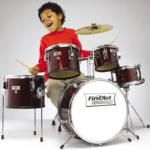The drums are an instrument that can seem daunting at first glance. Out of all the musical instruments, drums have the most bits and pieces to learn how to play by far. Unlike the violin or a woodwind, like a clarinet, the drums have different parts and types of drums that are all played at the same time. Like all instruments, the drums serve a purpose which is to help emphasize the rhythm of the song, without them, there’s little reinforcement for the listener to follow along. Let’s start by digging into what all goes into a typical 5-piece drum kit (or drum set).
In a 5-piece drum set, there’s one bass drum, one snare drum, 3 toms (high, mid and low), and cymbals. Starting with a bass drum (commonly known as the kick drum), it’s located in the center of the drum kit. A foot pedal attaches to the rim (hoop) of the drum which would be operated by your dominant foot. The bass drum is generally used to play the 1 and 3 beats in a 4/4 (four quarter-note beats) rhythm.
The snare drum is a percussion instrument that forms the center of the drum kit and is one of the most important drums in the kit. They are essential in adding to the beat and help set up the pulse or tempo for the rest of the instruments. It’s played with drumsticks and is often played in a wide variety of ways in many genres of music. The snare drum is constructed of two heads, both usually made of plastic along with a rattle of metal wires on the bottom head called the snares.
The toms (or tom-toms) come in three sizes (typically ranging from 6 and 20 inches in diameter) that are placed high, mid and low/floor levels on the drum kit. Drums have different “voices” and the toms provide the tenor parts to a balanced drum sound.
The final element in a drum kit is the cymbals. The use of cymbals for percussion music was revolutionized by the cymbal stand and pedals. They allowed drummers to crash cymbals with only one hand or none at all, opening up the way to more complicated percussion music. There are several different types of cymbals regularly used with a percussion set such as, hi-hats, ride, crash, china, etc., which bring different sounds to the type of music being played.
The importance of the rhythm section is helping the listener to find the beat in time. The drums are clearly a rhythm instrument, so it helps to keep the listener aware of where the beats are. Also, the main theme for drums is to help emphasize upcoming changes in parts of a song.
The drums are typically found in bands (high school or other) or orchestra’s in many different types of music genres such as jazz, rock, country, blues, etc.. Omaha provides many opportunities to utilize the drums in locations all over the city in a multitude of ways, and the best way to learn how to play the drums would be at the Omaha School of Music and Dance!
There are many benefits that come with learning how to play the drums. Some of the benefits include:
- Increased concentration and focus
- When you are taking drum lessons and practicing at home, concentration is key and you need to be able to focus on not only playing with both hands but reading the sheet music as well.
- Improve your music knowledge
- When you learn how to play the drums, many opportunities can arise from mastering them, it can open your mind to other musical instruments you may want to try your hand at or even introduce you to music genres you never heard of.
- Gets you involved
- Playing the drums can help you get involved in your school or you can get to know many other people who also play the drums and share the same interest in music!
There are many other benefits to playing the drums and taking lessons, if you want to get signed to take lessons, our teachers here at Omaha School of music and Dance are all university trained and would love to teach you! You can visit us in person, we are located right off of 144th and Dodge at 14505 California St., you can give us a call at (402) 515-9639, or visit our website OSMD.



